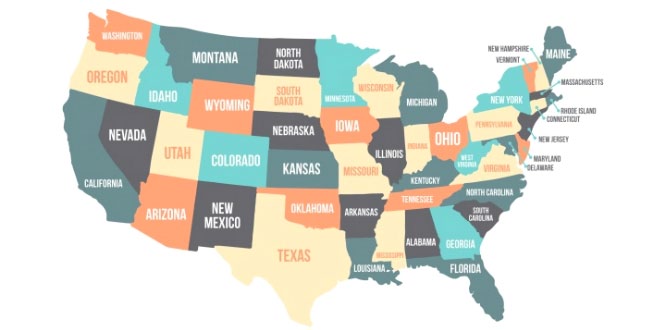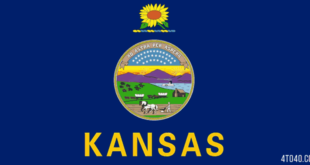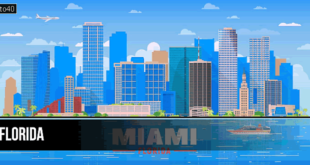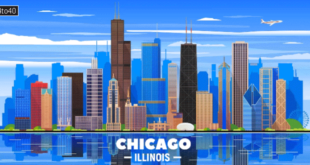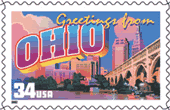 Because of its advantageous alignment with Lake Erie and the Ohio River and its general accessibility, Ohio early in its history assumed its corridor function, channeling people and goods west or east and north or south. The Ohio Country became the first destination for settlers and pioneers on their way farther into the interior. In 1803, Ohio became the 17th state to join the Union and the first to be admitted from the Northwest Territory–a reflection of the area’s rapid population growth in what became the first territory of the United States. Its name is derived from an Iroquois word meaning “beautiful”.
Because of its advantageous alignment with Lake Erie and the Ohio River and its general accessibility, Ohio early in its history assumed its corridor function, channeling people and goods west or east and north or south. The Ohio Country became the first destination for settlers and pioneers on their way farther into the interior. In 1803, Ohio became the 17th state to join the Union and the first to be admitted from the Northwest Territory–a reflection of the area’s rapid population growth in what became the first territory of the United States. Its name is derived from an Iroquois word meaning “beautiful”.
Ohio State: Land & Resources
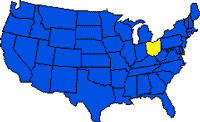 Ohio shares parts of two major physical provinces of the continental United States–the Appalachian Plateau and the Central Lowland. The boundary between these regions cuts the state in two along a northeast-southwest line extending from southwest of Cleveland to the Ohio River in Adams County. The two regions are distinguished by their relief and elevation, with higher, more rugged land in the plateau areas and less elevated, level terrain in the lowland province.
Ohio shares parts of two major physical provinces of the continental United States–the Appalachian Plateau and the Central Lowland. The boundary between these regions cuts the state in two along a northeast-southwest line extending from southwest of Cleveland to the Ohio River in Adams County. The two regions are distinguished by their relief and elevation, with higher, more rugged land in the plateau areas and less elevated, level terrain in the lowland province.
Continental glaciation and stream erosion were the primary agents in the formation of the state’s topography. The effects of glaciation further divided the two major regions into five physiographic regions: the northern lake plain, the western till plain, the glaciated plateau, the unglaciated plateau, and the Lexington plain.
The lake plain encompasses the northernmost part of Ohio. It is as narrow as 8 km (5 mi) in the east, but widens to ten times that distance toward the Indiana border. In the eastern plateau section, the land becomes increasingly hilly. The glaciated plateau occupies the northeastern part of the state, while relatively high relief adjacent to the Ohio River characterizes the unglaciated plateau to the southeast. In this southern plateau region, local relief may be as high as 210 m (700 ft). The western till plain corresponds with the Central Lowland and is essentially of low relief and elevation except for Mount Campbell, an erosional remnant that has undergone slow uplift. The latter’s elevation of 472 m (1,550 ft) is the highest in Ohio. The Lexington plain is a small northward extension into southwest Ohio of residual limestone soils of Kentucky’s Bluegrass Basin.
Ohio’s geology is relatively simple. Bedrock consists of basically undisturbed Paleozoic sediments. Because the rock layers dip slightly toward the east, the older Paleozoic formations are nearer the surface in western Ohio, while younger strata are found in the east. In western Ohio limestone and dolomite are widespread. Toward the east sandstones and shales are more prevalent.
Climate
Except for a small area along the Ohio River, a humid continental climate dominates the state. Large seasonal temperature changes are common, with January temperatures averaging below 0 deg C (32 deg F) and July temperature averages exceeding 24 deg C (75 deg F). Precipitation occurs year-round and averages between 762 mm (30 in) and 1,016 mm (40 in). Slightly higher precipitation falls during the summer, and autumns are relatively dry.
Ohio’s climate reflects its mid-latitude and eastern location. Cyclonic systems in the westerly wind belt create variability in weather. More localized factors affecting climate are Lake Erie and the eastern hill and valley topography. In spring proximity to the lake prevents late freeze-outs, thereby benefiting the area’s vegetable and fruit production. In winter it results in heavier snowfall over northeastern Ohio. The Appalachian foothills have an important local climatic effect, creating frequent temperature inversions. This condition results in frosts in late spring and early fall and an overall shorter growing season. A more serious effect is the trapping of pollutants in highly industrialized portions of the upper Ohio River valley.
Tourism
Tourism is a major business in Ohio, adding substantially each year to the economy. State recreation areas and local parks cover many areas of the state. Ohio’s presidential memorial sand homes are leading attractions. The state’s recreational sites, while not necessarily unique, are diverse and offer both summer and winter activities.
Ohio State: History
Ohio’s earliest occupants probably followed retreating glaciers into the area while hunting mastadon and giant beaver. The earliest inhabitants were followed by the more advanced MOUND BUILDERS who ranged over Ohio between 1000 BC and 800 AD. They were noted for their burial practices, evidence of which remains in some 6,000 burial and ceremonial mounds.
Probably the first European to set foot in the Ohio Country was either Robert Cavelier, sieur de LA SALLE, or Louis JOLLIET. Between 1669 and 1670, La Salle explored the Ohio River area and Jolliet journeyed along Lake Erie. Based on La Salle’s exploration and resulting map, the French later laid claim to the entire Ohio Valley. Both French and English hotly contested their control of the Ohio territory before permanent American settlement.
Among the historic Indian groups in Ohio were the ERIE, HURON (Wyandot), OTTAWA, and TUSCARORA in the north; the Mingo (or IROQUOIS LEAGUE) in the east; the DELAWARE and SHAWNEE in the south; and the MIAMI in the west. Remnants of these tribes, led by the Shawnee chief Blue Jacket, were defeated at the Battle of FALLEN TIMBERS in 1794. This U.S. Army victory led to the establishment of the Greenville Treaty Line in 1795, which separated the Indian land to the northwest from the settlers’ land to the east and south.
The Ohio Country became part of the NORTHWEST TERRITORY in 1787. With the passage of the Ordinances of 1785 and 1787, providing for stable government as well as land survey and sales in the territory, settlement by Anglo-Americans accelerated. Connecticut and Virginia retained title to Ohio land, forming the Connecticut Western Reserve in the northeast and the Virginia Military District between the Little Miami and Scioto rivers in the southwest. The OHIO COMPANY OF ASSOCIATES acquired 4,856 sq km (1,875 sq mi) in southeastern Ohio and in 1788 founded Ohio’s first town, MARIETTA, at the confluence of the Muskingum and Ohio rivers.
Ohio statehood was guaranteed when more than 5,000 adult males were counted during the area’s census of 1797. In 1803, Ohio entered the Union with Edward Tiffin as its first governor. CHILLICOTHE was the state capital from 1803 to 1810, when it was replaced by ZANESVILLE. Chillicothe again was capital from 1812 to 1816, when Columbus assumed the honor.
The state’s early years were characterized by dramatic population increases and political and military turmoil. Political intrigue was fomented by the supposedly treasonous activities of Aaron BURR on an Ohio River island owned by Harman BLENNERHASSETT. Military problems resulted from Indian agitation and the campaigns of the WAR OF 1812. Two names forever to be connected with Ohio and its early struggles are TECUMSEH and William Henry HARRISON. The first was the great Shawnee chief who almost succeeded in rallying the Indians for a last stand against the white man. The latter was the victor in the fight to bring peace to the New West and was the first of eight U.S. presidents from Ohio.
Transportation opened Ohio to internal development. Favored by navigable waters north and south, overland transportation surged with completion of the NATIONAL ROAD through the state in 1838, and of the Ohio-Erie and Miami-Erie canals in 1832 and 1847, respectively. Ohio’s railroad network was begun with the Dayton-Sandusky line in 1850. Efficient transportation gave impetus to the coal industry and boosted farm income and land values in the western and northern agricultural areas. By the Civil War period, Ohio had achieved national status as an agricultural and industrial state.
Preceding the Civil War, Ohio was strongly identified with abolitionist causes. The UNDERGROUND RAILROAD was active along the Ohio River and on Lake Erie. The abolitionist movement received wide support, and in 1848, Ohio repealed its Black Laws, which had been restrictive of blacks’ civil rights. The Civil War was carried into Ohio during a cavalry foray led by Gen. John Hunt MORGAN. The “invasion” lasted from July 13 to July 26, 1863, ending with the surrender of Morgan and his men and their imprisonment as horse thieves rather than combatants.
After the Civil War, Ohio became a political power on the national level. Seven U.S. presidents were born in Ohio: Ulysses S. Grant, Rutherford B. Hayes, James A. Garfield, Benjamin Harrison, William McKinley, William Howard Taft, and Warren G. Harding.
As an industrial state, Ohio felt the brunt of the labor movement. The American Federation of Labor was formed in Columbus in 1886, followed by the United Mine Workers in 1888. Violence connected with labor unrest became commonplace in the mining areas of southeastern Ohio. During a strike in 1884 several mine shafts in Perry County were set afire and have been burning ever since. Estimates indicate that 50 million tons of coal have been consumed, and despite a system of barricades and packing mud into the tunnels, some smoke from the fire is still visible.
During the 20th century Ohio moved to the forefront of the industrial states under the business leadership of such men as Benjamin F. GOODRICH, Charles Franklin KETTERING, and John D. Rockefeller. Two world wars and conflicts in Korea and Vietnam triggered massive industrialization, rapid in-migration, and subsequent urbanization. Ohio’s fortunes can, however, be rapidly reversed by economic relocation such as a shift from coal to natural gas or by recession. These trends have had devastating results in the central cities and the traditional coal mining districts in Appalachia, where unemployment and poverty are chronic ills. Beset by over capitalization, outdated facilities, and entrenched labor unions, Ohio struggles to keep the very industries which made it a manufacturing giant. Ohio still retains its great locational advantage, however, and its vast coal reserves once more offer renewed industrial viability.
Ohio State: Land
- Area: 116,103 sq km (44,828 sq mi); rank: 34th.
- Capital and largest city: Columbus (1990 pop., 632,910).
- Counties: 88.
- Elevations: highest–472 m (1,549 ft), at Campbell Hill; lowest–139 m (455 ft), at the Ohio River.
Ohio State Symbols
Flag:

Statehood:
March 1, 1803; the 17th state
Nickname:
Buckeye State
Bird:

Tree:
Buckeye
Flower:

 Kids Portal For Parents India Kids Network
Kids Portal For Parents India Kids Network
